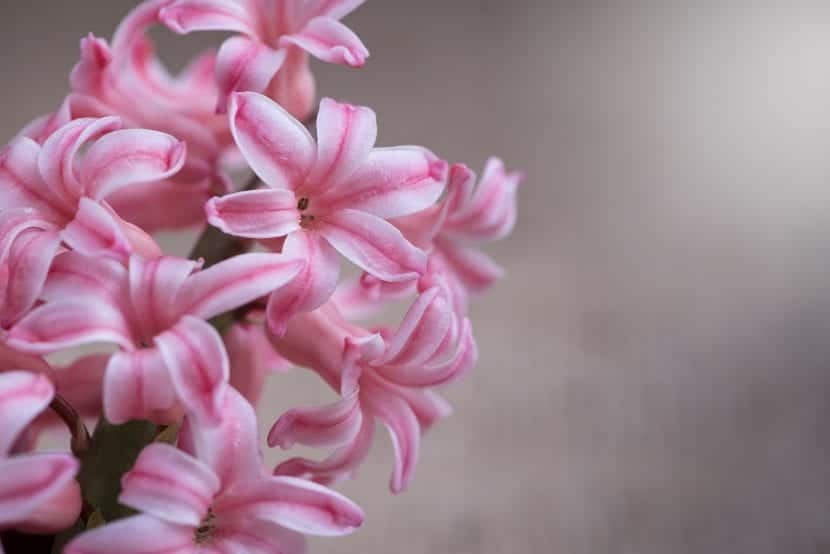
We tend to think that ornamental flowering bulb plants have to be exposed to direct sunlight, which, I am not going to fool you, it is true but only partially. There are several bulbous plants that need little light. There are not many, but the ones that exist are enough to have a very special corner.
If you do not believe me, take a look at our selection and boasts of home .
Bulbous types for low-light locations
Anemone

La anemone Although it is not a bulbous but a tubercular plant, considering it is seasonal, we could not fail to add it to the list. It is native to the mountains of China and Japan, and reaches a height between 15 and 25cm. Produces flowers in spring. These, although normally small (3cm), appear in such quantity that it is a joy to see them. The colors of its petals are: white, red, purple, orange.
lily

El Lilium It is a perennial bulbous herbaceous plant native to the temperate regions of the northern hemisphere. There are a total of 110 different species, with one height between 30 and 60cmand all of them produce impressive flowers: they are large, very brightly colored, and also exhale a strong fragrance, especially at night. Its flowering time is in summer, so it must be planted in spring.
Cala

The plants known as bays, gannets or cartridges, belonging to the genus Zantedeschia, are herbaceous rhizomatous native to southern Africa. They reach a height between 40 centimeters and 2,5mdepending on the species and / or cultivar. During spring they produce flowers grouped in spathe-shaped inflorescences of white, yellow or pink color.
Cyclamen

El cyclamen, known as artánita, is a beautiful herbaceous plant with tuberous roots native to the Mediterranean region to Central Europe that reaches a height of about 30-35 centimeters. It produces red, pink, yellow or white flowers in the spring.
clivia

La clivia is a rhizomatous plant native to South Africa that reaches a height of 50 centimeters. Its beautiful flowers appear during spring, grouped in a dense and compact reddish-orange inflorescence.
Hyacinth

El hyacinth, or Hyacinthus, is a bulbous perennial native to the Mediterranean region and southern Africa. Reaches a height of 20-30 centimeters. During spring it produces flowers grouped in very dense spike-shaped inflorescences of very fragrant red, blue, white or yellow color.
Narciso

El narcissus, or Narcissus, is a bulbous perennial native to the Mediterranean basin that reaches a height of up to 50 centimeters. The flowers, which sprout in spring, arise from a floral stem, are shaped like umbels and are of various colors: white, yellow, bicolor (yellow with white, or white with orange).
Buttercups

The buttercups, also known as francesillas or marimoñas, are plants with tuberous roots native to Southeast Europe and Asia Minor. They reach a height between 40 and 60 centimeters. The flowers, which sprout in spring, are large, 4-5cm in diameter, and very bright colors: yellow, orange, red, pink, white …
How are these plants cared for?
After this selection, we are going to give you many tips so that you can have your bulbous plants that need little light in perfect condition:
Plant them three months before flowering

For example, if we are interested in having a bulbous that blooms in spring, we have to acquire the bulb in late autumn or early winter, since it will be at that time when we have to plant it.
Choose the right container
If we are going to have them in pots, It is important to choose a container that is at least twice as high as the bulb itself and twice as wide.. For plants that tend to occupy a lot of space, such as buttercups or calla lilies, the ideal is to plant them in wide pots, about 30cm.
Keep the soil moist but not waterlogged
Keep in mind that shady places are precisely like this because the sun’s rays do not reach directly, so the soil or substrate takes longer to dry. Therefore, it should be watered only when necessary (when we see that the earth begins to be dry), avoiding waterlogging at all times.
Fertilize them from time to time
To get a greater quantity of flowers, it is highly advisable to pay them from the first moment the leaves sprout. For it, we can use specific liquid fertilizers for bulbous plantsor with organic fertilizers also liquid such as guano. Regardless of what we use, we have to read the indications specified on the product packaging.
Protect them from frost

Bulbous such as cyclamen or anemones, need protection against strong frosts. To prevent them from having problems, what we can do is protect them with anti-frost fabric o placing them inside a bright room away from drafts.
Did you like this article? Do you know other bulbous plants that need little light?
